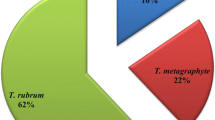Abstract
Kodamaea ohmeri and Prototheca wickerhamii are rare pathogens for humans, and even more rare as cause of onychomycosis. This work reports the second case of onychomycosis by K. ohmeri and the fourth of onycoprotothecosis; it was made in public health institutions in the Hidalgo State, Mexico, studying 261 diabetic patients during 2005 and 2006. Kodamaea ohmeri was isolated from toenails of a 51-year-old female patient, and P. wickerhamii from three female patients of 48, 49, and 61 years old, respectively, all of them with type 2 diabetes mellitus (DM 2). Identifications were done by standard microbiological methods and a commercial system. Only one patient infected with P. wickerhamii showed mixed infection with dermatophytes. Out of the total studied DM 2 patients, 1.15% presented onycoprotothecosis and 0.38% onychomycosis by K. ohmeri, high percentages if it is considered that few cases have been reported of K. ohmeri and P. wickerhamii as onychomycosis causal agents.


Similar content being viewed by others
References
Mayser P, Freund V, Budihardja D. Toenail onychomycosis in diabetic patients. Am J Clin Dermatol. 2009;10:211–20.
Gupta AK, Humke S. The prevalence and management of onychomycosis in diabetic patients. Eur J Dermatol. 2000;10:379–84.
Rich P, Hare A. Onychomycosis in a special patient population: focus on the diabetic. Int J Dermatol. 1999;38:17–9.
Piérard GE, Piérard-Franchimont C. The nail under fungal siege in patients with type II diabetes mellitus. Mycoses. 2005;48:339–42.
Dogra S, Kumar B, Bhansali A, Chakrabarty A. Epidemiology of onychomycosis in patients with diabetes mellitus in India. Int J Dermatol. 2002;41:647–51.
Hazen KC. New and emerging yeasts pathogens. Clin Microbiol Rev. 1995;8:462–78.
Yamada Y, Suzuki T, Matzuda M, Mikata K. The phylogeny of Yamadazyma ohmeri (Etchells et Bell) Billon-Grand based on the partial sequences of 18S and 26S ribosomal RNAs: the proposal of Kodamaea gen. nov. (Saccharomycetaceae). Biosci Biotechnol Biochem. 1995;59:1172–4.
Otag F, Kuyucu N, Erturan Z, et al. An outbreak of Pichia ohmeri infection in the paediatric intensive care unit: case reports and review of the literature. Mycoses. 2005;48:265–9.
De Barros JD, Do Nascimento SM, De Araújo FJ. Kodamaea (Pichia) ohmeri fungemia in a pediatric patient admitted in a public hospital. Med Mycol. 2009;47:775–9.
Han XY, Tarrand JJ, Escudero E. Infections by the yeast Kodamaea (Pichia) ohmeri: two cases and literature review. Eur J Clin Microbiol Infect Dis. 2004;23:127–30.
García-Tapia A, García-Agudo R, Marín P, Conejo JL, García-Martos P. Kodamaea ohmeri fungemia associated with surgery. Rev Iberoam Micol. 2007;24:155–6.
Puerto JL, García-Martos P, Saldarreaga A, et al. First report of urinary tract infection due to Pichia ohmeri. Eur J Clin Microbiol Infect Dis. 2002;21:630–1.
Manzano-Gayosso P, Hernández-Hernández F, Méndez-Tovar LJ, et al. Onychomycosis incidence in type 2 diabetes mellitus patients. Mycopathologia. 2008;166:41–5.
Lass-Flörl C, Mayr A. Human protothecosis. Clin Microbiol Rev. 2007;20:230–42.
Boyd A, Langley M, King L. Cutaneous manifestations of Prototheca infections. J Am Acad Dermatol. 1995;32:758–64.
Marques S, Silva E, Carvalheira J, Thompson G. In vitro antimicrobial susceptibility of Prototheca wickerhamii and Prototheca zopfii isolated from bovine mastitis. J Dairy Sci. 2006;89:4202–4.
Pérez-Melón C, Camba M, Tinajas A, et al. Prototheca wickerhamii peritonitis in patients on peritoneal dialysis. Nefrología. 2007;27:81–2.
Stenner VJ, Mackay B, King T, et al. Protothecosis in 17 Australian dogs and a review of the canine literature. Med Mycol. 2007;45:249–66.
Leimann B, Monteiro P, Lazera M, Candanoza E, Wanke B. Protothecosis. Med Mycol. 2004;42:95–106.
Huerre M, Ravisse P, Solomon H, et al. Human protothecosis and environment. Bull Soc Pathol Exot. 1993;86:484–8.
Magerman K, Gordts B, Hindryckx P, Van Landuyt HW. Isolation of Prototheca zopfii from a finger. Case report and review of the literature. Acta Clin Belg. 1991;46:233–6.
Marcano C, Feo M. Prototheca zopfii colonizing the nail. Mycopathologia. 1981;75:89–92.
Galán F, García-Martos P, Palomo M, et al. Onychoprotothecosis due to Prototheca wickerhamii. Mycopathologia. 1997;137:75–7.
Kam KM, Au WF, Wong PY, Cheung MM. Onychomycosis in Hong Kong. Int J Dermatol. 1997;36:757–61.
Zaitz C, Godoy AM, de Sousa VM, et al. Onycoprotothecosis: report of the first case in Brazil. Int J Dermatol. 2006;45:1071–3.
Quindós G, Vargas RA, Helou S, et al. Evaluación micológica de un nuevo medio de cultivo cromógeno (Candida ID®) para el aislamiento e identificación presuntiva de Candida albicans. Rev Iberoam Micol. 2001;18:23–8.
Bergman MM, Gagnon D, Doern GV. Pichia ohmeri fungemia. Diagn Microbiol Infect Dis. 1998;30:229–31.
Acknowledgments
This work was supported by a Grant (SEP-PROMEP UAEH CA-25) from the Secretaría de Educación Pública, Mexico.
Author information
Authors and Affiliations
Corresponding author
Rights and permissions
About this article
Cite this article
González-Avila, M., Gómez-Gómez, J.V., Espinosa Texis, A.P. et al. Uncommon Fungi Isolated from Diabetic Patients Toenails With or Without Visible Onychomycoses. Mycopathologia 172, 207–213 (2011). https://doi.org/10.1007/s11046-011-9417-7
Received:
Accepted:
Published:
Issue Date:
DOI: https://doi.org/10.1007/s11046-011-9417-7




